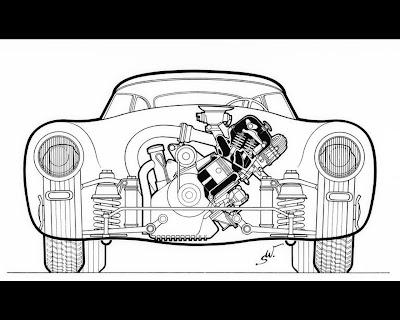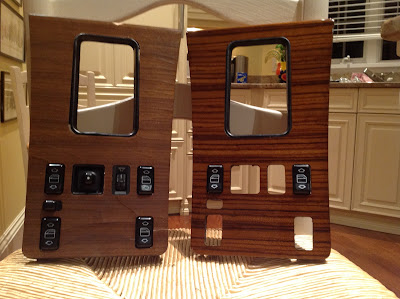The Mercedes SL-Class is and will forever be a motoring
icon. It’s also one of my favorite automotive stories of all time. A car born out of racing pedigree,
transformed into road going art-on-wheels and continually re-designed over 5
generations of SL’s with each becoming a benchmark for this segment. Though it may seem like a flawlessly executed
plan, the SL almost didn’t make it into production.
The story begins in 1951 when a war-shaken Mercedes built a
stunningly beautiful racing machine—dubbed the 300SL for the 3.0L, inline
6-cylinder engine it used—with the goal of bringing Mercedes back into the
motorsport arena and ultimately winning Le Mans. Among its most notable characteristics was
its breath taking shape and unique gullwing doors, both of which were the
results of some incredible engineering. The light-weight, aluminum built body was
designed to have an incredibly low drag coefficient while the doors were a
result of a tubular space frame chassis, which gave the car incredible strength
and rigidity but made conventional doors impossible. These characteristics, along its powerful
175hp engine allowed Mercedes-Benz to achieve its goal of winning Le Mans in
1952. Not only did they take
first and second place, but they did so with a record breaking average speed of
155.575 Kph.
 |
| Engine mounted at angle to lower center of gravity |
 |
| 1952 Le Mans: First and Second |
The production 300SL would be a feat of modern engineering
and a design that would forever leave its mark on the industry. Featuring the same iconic ‘gullwing’ doors
and profile as the race car on which it was based, Mercedes continued to
improve upon the design with the consumer in mind. The result was a car that was dizzyingly
gorgeous. Moreover, relying on a
modified version of the 3.0L racing engine, the 300SL was able to hit a top speed
of ~160 MPH, making it the fastest production car at the time. And, the independent suspension lifted from
its racing cousin meant that the beautiful body and all that power could go
round corners with relative precision—a characteristic that was not shared by
many other cars during this time.
Anyone looking to buy a 300SL would need quite a sizeable
check book as it would set you back roughly $11,000 at its initial offering in
1955, though the price would later be reduced to about $7,500 after achieving production
efficiencies (around $95k/$65k in 2012 dollars). That said, with only about 1400 of these
ultra-beautiful automotive specimens produced between 1955 and 1957, they
currently fetch anywhere from $700,000-$4,000,000 depending the car and its
condition.
After realizing the somewhat impractical nature of these
‘gullwing’ cars (they were exceptionally toasty while driving due to poor
ventilation and difficult to get in and out of), Mercedes ceased production in
‘57 in favor of building a roadster version of the 300SL for the more refined,
gentleman motorist. This roadster
maintained the gorgeous shape of the original 300SL but utilized a different
chassis structure to allow the fitment of more conventional doors. There were also improvements made to the
engine, braking system and suspension, which gave the car enhanced performance. This SL’s price once again spiked back up to
the $11,000 mark and as a result only about 1858 units were produced between
1958 and 1963.
Those with slightly less means can thank Max Hoffman for
dreaming up the 190SL, which was a fantastic alternative to its pricier big
brother. While it shared a great deal of
styling cues with the 300, the rest of the cars underpinnings were changed in
order to make it more affordable and drivable on a daily basis. Its chassis and suspension were transplanted
from the 180-series, which enabled the car to have conventional doors and a
more comfortable ride. A new 1.9L engine
was developed specifically for this car with an output rating of 120hp. All of these changes added up to a price of $3,998
for a soft-top only model or $4,295 with the optional hard top when it went on
sale in 1955 (about $34,500/$37,000 in 2012 dollars). With such beautiful styling, sporty ride and
such a reasonable price (compared to the 300SL), the 190 sold a staggering
25,881 units during its production from 1955-1963.
There is so much that I really like about this story. First and foremost would certainly be how the
production car came to be. It was the
vision of an incredible company with one purpose and the mission one man who
saw its potential as a production car. Both
parties put a lot on the line, Mercedes for producing a “less than practical”
car at a ridiculous price point and Max for agreeing to order 1000 of them
before Mercedes even agreed to produce it. It also shows how great ideas can come from
anywhere. Max had his fingers on the
pulse of the market and thus really was able to understand why this car would be
such a success. Lastly, I love how this car was not ruined by
the production process. So often we see
breath taking concept cars that captivate the hearts and minds of consumers,
only to be destroyed in its transition from concept to production car. I understand that car companies must make a
profit and to some extent consumer products need to have a hint of practicality
but sometimes we must be guided by our senses and visceral reactions; we need
to build stunningly beautiful, amazing and impractical things. All in all, I pray nightly that I might one
day be graced with the opportunity to drive either a 300 or 190, for they truly
are a beautiful part of motoring history.
As I mentioned above, this is only part 1 of the story so
check back for part 2: 1963-1971 and the SL Pagoda.







































